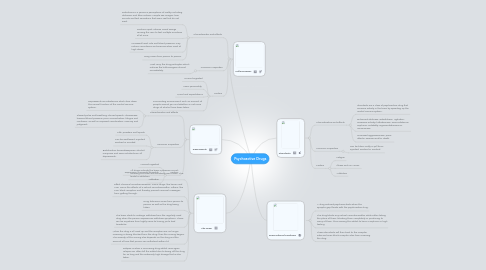
1. Depressants
1.1. Characteristics and Effects
1.1.1. Depressants are substances which slow down the normal function of the central nervous system.
1.1.2. Slowed pulse and breathing, slurred speech, drowsiness, lowered blood pressure, poor concentration, fatigue and confusion, as well as impaired coordination, memory and judgment.
1.2. Common Properties
1.2.1. Pills, powders and liquids.
1.2.2. Can be swallowed, injected, smoked or snorted.
1.2.3. Barbiturates, benzodiazepines, alcohol, marijuana and some inhalants are all depressants.
1.3. Factors
1.3.1. Amount ingested
1.3.2. Depression or suicidal thoughts
1.3.3. Addiction
2. Hallucinogens
2.1. Characteristics and Effects
2.1.1. Distortions in a person's perceptions of reality, including delusions and false notions. People see images, hear sounds and feel sensations that seem real but do not exist.
2.1.2. Produce rapid, intense mood swings causing the user to feel multiple emotions all at once.
2.1.3. Increased heart rate and blood pressure, may induce convulsions and seizures when used at high doses.
2.1.4. Drug varies from person to person.
2.2. Common Properties
2.2.1. Most carry the drug psilocybin which induces the hallucinogens almost immediately.
2.3. Factors
2.3.1. Amount ingested
2.3.2. Users personality
2.3.3. Mood and expectations
2.3.4. Surrounding environment, such as, amount of people around you and whether or not more drugs of alcohol have been taken.
3. The Brain
3.1. All drugs activate the brain's pleasure circuit, meaning the brain will constantly want more. This leads to addiction.
3.2. Effect chemical neurotransmission. Some drugs, like heroin and LSD, mimic the effects of a natural neurotransmitter. Others, like PCP, block receptors and thereby prevent neuronal messages from getting through.
3.3. Drug tolerance varies from person to person as well as the drug being taken.
3.4. The brain starts to undergo withdraw from the regularly used drug when the person experiences withdraw symptoms. These can be anywhere from highly serve to having just a bad headache.
3.5. When the drug is all used up and the receptors are no longer receiving or being blocked from the drug, then the craving begins. The severity of the craving also depends on the drug and the amount of time that person can withstand without it.
3.6. Relapse is when a recovering drug addict uses again. relapse can often kill the addict due to being off the drug for so long and the extremely high dosage that is also taken.
4. Stimulants
4.1. Characteristics and Effects
4.1.1. Stimulants are a class of psychoactive drug that increase activity in the brain by speeding up the central nervous system.
4.1.2. Enhanced alertness, wakefulness, agitation, excessive activity, talkativeness, overconfidence, euphoria, irritability, argumentativeness or nervousness.
4.1.3. Increased aggressiveness, panic attacks, seizures and/or death.
4.2. Common Properties
4.2.1. Can be taken orally in pill form, injected, smoked or snorted.
4.3. Factors
4.3.1. Fatigue
4.3.2. Illness such as ADHD
4.3.3. Addiction
